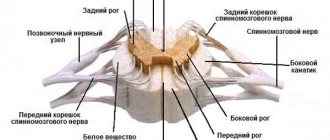Guillain-Barré syndrome is a severe autoimmune disease that affects the peripheral nervous system. The most common manifestation is acute tetraparesis, when movement of all four limbs becomes almost impossible. Other movements also cease, including swallowing, the ability to lift the eyelids, and spontaneous breathing. Despite this, the course of the disease is benign, most cases end in recovery. Transition to a chronic course or relapses are less common. Guillain-Barré syndrome occurs in all countries, regardless of their level of development, with the same frequency - approximately 2 cases per 100 thousand population, no dependence on gender. The disease can affect patients of all ages.
At CELT you can get advice from a neurologist.
- Initial consultation – 4,000
- Repeated consultation – 2,500
Make an appointment
Why does the syndrome occur?
The leading mechanism of development is autoimmune. In most cases, the onset of the disease occurs in the first three weeks after an acute respiratory or intestinal infection. Since a sufficient amount of time has passed since the moment of illness, and the symptoms characteristic of the infectious process have time to pass, the patients themselves, as a rule, do not associate these conditions with each other. The cause may be pathogens such as:
- Epstein-Barr virus or human herpes type 4;
- mycoplasma;
- Campylobacter, which causes infectious diarrhea;
- cytomegalovirus.
Researchers have found that the “sheath” of these pathogens is similar to the myelin sheath of the axon of peripheral nerves. This similarity causes the nerves to be attacked by antibodies, which are initially produced and circulate in the blood in response to the appearance of an infectious agent. This phenomenon is called “molecular mimicry” and explains why immune complexes attack the body’s own tissues.
Cases have been described when the syndrome occurs after vaccination, after surgery and abortion, hypothermia, and stress. In some cases, the cause cannot be found.
How does the syndrome manifest?
Over the course of several days, up to a maximum of 1 month, muscle weakness in the legs increases, and difficulties arise when walking. Next, the hands weaken, the last to suffer is the facial muscles. Such symptoms have a separate name - ascending Landry's paralysis.
But sometimes the paralysis begins from above, from the arms, spreading downwards, but all limbs are always affected.
Every fifth case is accompanied by paralysis of the trunk muscles, namely the diaphragm and intercostal muscles. With such paralysis, breathing becomes impossible and artificial ventilation is required.
A common manifestation is bulbar syndrome or bilateral paralysis of the muscles of the soft palate, when swallowing and clear speech are impossible.
Together with motor fibers, sensory fibers are sometimes affected. Sensory disturbances develop, tendon reflexes decrease, and pain in the limbs occurs. The pain is of a pronounced “neuropathic” nature - burning, a feeling of current passing, tingling. Pelvic disorders are rare, but most often there is urinary retention, which in some cases is combined with excess urine production.
Autonomic dysfunction is added, which is manifested by fluctuations in blood pressure, palpitations, other heart rhythm disturbances, sweating, and lack of intestinal motility.
Symptoms
| Occurrence (how often a symptom occurs in a given disease) | |
| Rapidly increasing muscle weakness in the legs | 100% |
| Numbness of the foot (foot hypoesthesia) | 80% |
| Difficulty swallowing (dysphagia, difficulty swallowing, swallowing disorder) | 60% |
| Numbness of the hand | 60% |
| Foot pain worsens with physical activity | 50% |
| General weakness (fatigue, tiredness, weakness of the body) | 50% |
| Girdle pain on the torso | 30% |
| Difficulty in inhaling | 30% |
| Increased blood pressure (high blood pressure, hypertension, arterial hypertension) | 20% |
| Decreased blood pressure (low blood pressure, hypotension) | 20% |
| General increase in body temperature (fever, fever) | 10% |
| Numbness around the mouth | 10% |
| Attacks of respiratory arrest | 10% |
Diagnostic measures
Diagnosis is based on WHO recommendations. There are two leading diagnostic criteria:
- muscle weakness in the limbs that progresses;
- decreased or absent tendon reflexes from the first days of the disease.
WHO also identifies additional signs that confirm the diagnosis, which include:
- symmetry of the lesion;
- symptoms increase within no more than 4 weeks;
- sensory disturbances of the “gloves and socks” type;
- involvement of the cranial nerves, especially the facial nerve;
- possible spontaneous restoration of functions after stopping the progression of the disease (the so-called “plateau”);
- the presence of vegetative disorders;
- absence of hyperthermia (if there is fever, it is caused by other infections);
- an increase in the amount of protein in the cerebrospinal fluid, while its cellular composition does not change (protein-cell dissociation).
Definitive diagnosis is impossible without electroneuromyography or ENMG. This test reveals which part of the nerve is damaged - the myelin sheath or the axon. ENMG also accurately determines the extent of the lesion, its severity and the possibility of recovery.
Since, in addition to Guillain-Barré syndrome, there are a number of acute, subacute and chronic polyneuropathies, electroneuromyography allows for differential diagnosis between them and contributes to the development of correct treatment tactics.
Diagnosis often requires a lumbar puncture followed by a study of the cerebrospinal fluid, and tests such as:
- blood for autoantibodies to neuronal structures;
- blood for class A gammaglobulins (especially if immunoglobulin therapy is planned);
- biomarkers of neurofilament (part of the cytoplasm of a neuron);
- markers of tau protein (a special protein that destroys neurons).
Specialists at the CELT clinic additionally use their own differential diagnostic algorithms, which make it possible to reliably distinguish Guillain-Barré syndrome from other diseases that cause progressive muscle weakness in all extremities or tetraparesis.
Clinical picture
- The first clinical manifestations are often paresthesia (numbness, burning, tingling) and pain in the hands and feet, less often in the mouth and tongue.
- After this, general malaise and low-grade fever develop.
- Next, progressive muscle weakness appears (maximum severity develops by 4-5 weeks), which has a number of features:
- Symmetrical, as with other polyneuropathies.
— Ascending nature (first the lower limbs suffer, then the upper limbs are involved in the process).
— Involvement of facial muscles in the pathological process on both sides in 70%.
- More rare, but at the same time more dangerous, is the involvement of the swallowing and respiratory muscles; Oculomotor disturbances also sometimes occur.
- Weakening of reflexes and their complete loss.
- Autonomic disorders (orthostatic hypotension, supraventricular tachyardia, coldness and chilliness of the hands and feet, acrocyanosis, increased sweating and hyperkeratosis of the soles).
- A sharp decrease to the point of loss of vibration and proprioceptive sensitivity.
You should know that the diagnostic criteria for the disease are symmetrical progressive paresis in the limbs in combination with areflexia, appearing by 4-5 weeks of the disease (although the disease often reaches the peak of its severity by 2-3 weeks).
In favor of Guillain-Barré syndrome, the doctor should also be guided in the diagnostic search by such signs as: progression of symptoms up to 4 weeks, protein-cell dissociation in the cerebrospinal fluid, symmetry of symptoms, the presence of mild sensory disorders, changes in EMG (but it should be remembered that these are not obligate signs of disease)
Phases of the disease:
- The progression phase usually lasts 2-4 weeks and is characterized by an increase in these symptoms. If this phase lasts from 4 to 8 weeks, then the polyneuropathy is called subacute inflammatory demyelinating polyneuropathy. If this phase lasts more than 8 weeks, the disease acquires chronic status.
- The plateau phase lasts from 1 to 4 weeks and is characterized by stabilization of the patient’s condition.
- The recovery phase often lasts several weeks and sometimes months and is characterized by regression of symptoms and restoration of motor function.
Our doctors
Pankov Alexander Rostislavovich
Neurologist
40 years of experience
Make an appointment
Novikova Larisa Vaganovna
Neuropathologist, Candidate of Medical Sciences, doctor of the highest category
Experience 39 years
Make an appointment
Treatment rules
Today, two main pathogenetic methods of treating Guillain-Barré syndrome are known, and both are successfully used by CELT specialists. These are plasmapheresis and intravenous immunotherapy. These methods can be used in isolation or used in combination, it all depends on the specific clinical situation. Treatment is aimed at removing or neutralizing immune complexes circulating in the patient’s blood. Both treatment methods are equivalent and almost always lead to recovery. Treatment stops the process of destruction of peripheral nerves, shortens the recovery period, and helps reduce neurological deficits.
Plasmapheresis is a blood purification operation. Most often, hardware plasmapheresis is used on continuous separators, during which the blood taken from the body is divided into formed elements (or blood cells) and plasma (or serum). All toxic substances are in the plasma, so it is removed. The person is given back his own blood cells, diluted, if necessary, with plasma-substituting solutions or donor plasma. The duration of the procedure is about one and a half hours, the entire course consists of 3 or 5 sessions. No more than 50 ml/kg of plasma body weight is removed at a time.
During treatment, blood parameters are monitored: electrolytes, hematocrit, clotting time and others.
Intravenous immunotherapy is the administration of a human immunoglobulin class G drug. These immunoglobulins stop the production of antibodies to one’s own nerves, simultaneously reducing the production of substances that support inflammation. These drugs are indicated for the pathogenetic treatment of Guillain-Barré syndrome in both adults and children.
Simultaneously with specific treatment, careful patient care is provided, including the prevention of bedsores, pneumonia, and contractures. Treatment of concomitant infections is often required. Venous thrombosis is prevented, tube feeding is carried out, and excretory function is monitored. Bedridden patients undergo passive exercises, as well as early verticalization to avoid blood flow disorders. If there is a threat of developing contacture (immobility of joints), paraffin procedures are possible. If necessary, motor simulators based on biofeedback are used.
Patients with damage to myelin sheaths recover faster, while axonal damage requires a longer period of rehabilitation. Axonal lesions often leave behind neurological deficits that are difficult to correct.
Prevention
The main method is the complete cure of infections that we consider banal and habitual. Guillain-Barré syndrome often develops with a slight weakening of the immune system, which is possible in every person.
The easiest way to protect yourself is to check your current immune status. This will only take a few days, and any abnormalities detected can be treated in time.
Doctors at the CELT clinic have at their disposal not only the latest diagnostic equipment, but also the latest treatment techniques that have received worldwide recognition. The main role in prevention belongs to the patient who seeks examination and treatment in a timely manner.
Make an appointment through the application or by calling +7 +7 We work every day:
- Monday—Friday: 8.00—20.00
- Saturday: 8.00–18.00
- Sunday is a day off
The nearest metro and MCC stations to the clinic:
- Highway of Enthusiasts or Perovo
- Partisan
- Enthusiast Highway
Driving directions
Causes of Guillain-Barre syndrome
Since polyradiculoneuritis is autoimmune in nature, the reasons for its occurrence are not completely clear.
Scientists have found that in 80% of cases the disease is a consequence of severe viral infections, including HIV and herpes. Thus, after enteritis caused by the bacteria Campylobacter jejuni, the risk of developing the syndrome increases 100 times.
The disease can also be triggered by injuries that cause swelling or growth of tumors in the brain.
Other causes of Guillain-Barré syndrome also include:
- mechanical damage to peripheral nerves;
- surgical interventions;
- complications after vaccinations;
- taking medications (for example, pembrolizumab - used in cancer therapy).







